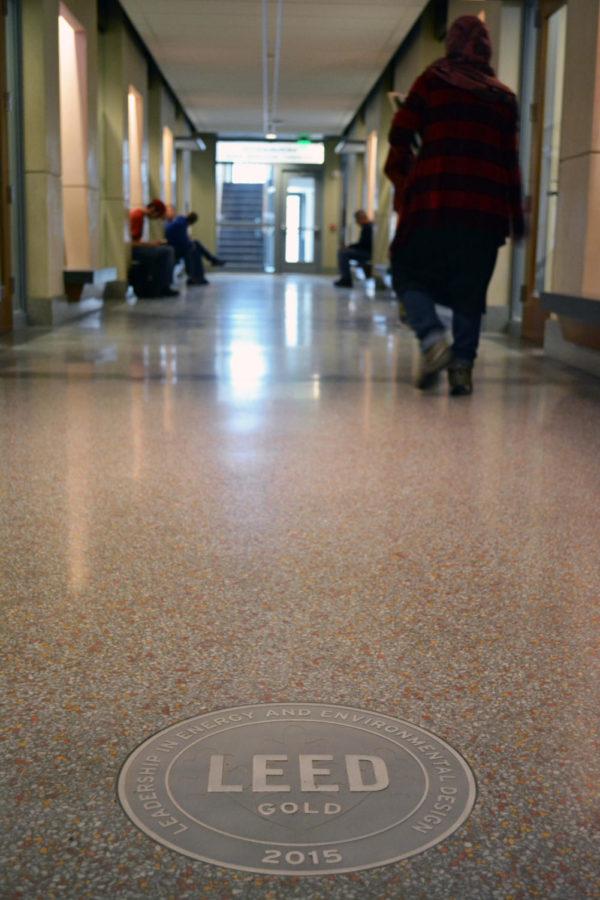Iowa State seeks LEED certification with new, old buildings
Katlyn Campbell/Iowa State Daily
A gold Leadership in Energy and Environmental Design (LEED) plaque adorns the hallway at Curtiss Hall in the Monsanto Student Services Wing.
February 27, 2017
Recycled blue jeans act as the insulation to keep students warm throughout the winter in King Pavilion.
Incorporating sustainable techniques into building design and construction at Iowa State is rewarded through the Leadership in Energy and Environmental Design certification program. LEED consists of a series of checkpoints that must be met in building design prior to earning a silver, gold or platinum certification level courtesy of the U.S. Green Building Council.
“There are a lot of things in LEED that are really good ideas that you should do, whether you’re building a LEED building or not,” Bradley Perkins, senior lecturer in civil, construction and environmental engineering, said.
Similar to Perkins, Beth Hartmann, senior lecturer in civil, construction and environmental engineering, sees implementing sustainable methods into buildings as necessary regardless of seeking certification or not.
“Even if you design and build a sustainable building, that doesn’t mean it has to be LEED certified,” Hartmann said. “Isn’t good design really sustainable design anyway?”
Perkins and Hartmann are both LEED accredited professionals and often teach about LEED concepts in their respective classes.
Kerry Dixon, coordinator of sustainable design and construction, oversees all LEED implementation at Iowa State construction projects.
Dixon helps coordinate Iowa State’s response with all of the paperwork and documentation revolved around certification. She also tracks what has positively impacted previous LEED projects so those same plans could be used in smaller renovation projects.
Certified Iowa State buildings receive a plaque when they are completed. However, participating in this LEED program means much more than receiving a simple award.
The LEED certification program revolves around the completion of different levels where one must accumulate points to achieve tasks on a checklist. Throughout the years, LEED has made it harder for buildings to obtain certification. Currently, LEED version 4 is being used to assess the status of new building projects. Regardless of these changes, Iowa State still strives to meet those marks.
“We build buildings that have a life expectancy of 50 to 100 years,” Dixon said. “Most developers are building 10- to 20-year buildings, so they’re looking for the fastest, cheapest way to build something. We’re building buildings that have to last.”
Along with this, the use of robust building methods within the structure and exterior of the buildings is going to be crucial in constructing a building that lasts.
Since 2005, Iowa State has achieved silver status three times, gold eight times and platinum twice.
Morrill Hall, the Bergstrom Football Complex and Lagomarcino Hall office remodeling all have achieved silver certification.
Hach Hall, Biorenewables Research Laboratory, Hixson-Lied Small Animal Hospital, Troxel Hall, Hansen Agriculture Student Learning Center, Curtiss Hall – Monsanto Student Services Wing, Curtiss Hall – Harl Commons and the Biorenewables Complex all have achieved gold certification.
King Pavilion and the State Gym Expansion and Renovation have both achieved platinum certification.
There are currently two other projects awaiting certification: Frederiksen Court and Marston Hall’s renovation.
“We want to build spaces that people want to be in,” Dixon said.
Everything from access to daylight, use of recycled carpeting to green roofs that reduce the heat-island effect is taken into consideration when planning for a new building project.
“The big thing with LEED is it’s just like a calc exam,” Dixon said. “Yeah, I can tell you, ‘Yes I did it. Here’s your answer.’ But they’re asking us to show our work just like a calc exam. It takes some time, and there is a cost to it but we can say somebody that wasn’t us reviewed this, graded it and we passed. [The U.S. Green Building Council] certified it.”
















